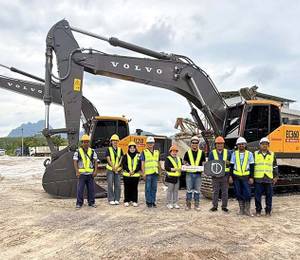The Land Transport Authority (LTA) marked the start of the Johor Bahru – Singapore Rapid Transit System (RTS) Link construction in Singapore today (22 Jan), with a groundbreaking ceremony.
The RTS Link is a 4-km rail shuttle service between the Singapore terminus at Woodlands North station and the Malaysia terminus at Bukit Chagar station in Johor Bahru. It has a capacity of up to 10,000 passengers per hour in each direction, with a journey time of about five minutes between the two stations.
The Customs, Immigration, and Quarantine (CIQ) facilities of Singapore and Malaysia will be co-located at Woodlands North and Bukit Chagar stations. As such, passengers only need to clear the immigration authorities once, i.e. at their point of departure.
When the RTS Link opens for service at the end of 2026, it is expected to significantly improve connectivity between Singapore and Johor Bahru, and also ease congestion along the Causeway.
The first of two civil contracts for the construction of the RTS Link in Singapore was awarded to Penta-Ocean Construction Co Ltd. It covers the construction of the RTS Link Woodlands North station, tunnels and the CIQ building in Singapore. LTA said the second civil contract covers the construction of the RTS Link viaduct, and is targeted to be awarded in the first quarter of 2021.
According to LTA, the RTS Link Woodlands North station will be constructed underground at a maximum depth of 28 m. There will be three stories, with two basement levels and an underground linkway to the CIQ building. “The RTS Link Woodlands North station and CIQ building are approximately 10 times the size of a typical MRT station. These facilities will be adjacent to Thomson-East Coast Line (TEL) Woodlands North MRT station and be seamlessly connected via an underground concourse. The tunnels will be connected to the viaduct that crosses the Straits of Johor at a height of 25 m.”
Ground conditions are expected to be challenging because it is a site of granite condition, LTA further revealed. Therefore, construction will involve the use of high-capacity drilling machines, extended piling works as well as rock demolition during the excavation works. “As construction activities will take place near an operational MRT station and ‘live’ utilities, these activities will be carefully managed to minimise impact to the general public and ensure the structural safety of the surrounding infrastructure. LTA will also implement additional measures such as real-time instrumentation monitoring and rigorous survey checks.”
LTA added that aside from the technical complexities, the cross-border nature of the construction also means that many stakeholders on both sides are involved. The Authority stressed that “both sides have been in close discussions and coordination to ensure the smooth and timely implementation of the RTS Link project. The Land Transport Authority remains committed to working closely with all relevant parties to see through the successful implementation of the RTS Link project.”
Images: LTA















